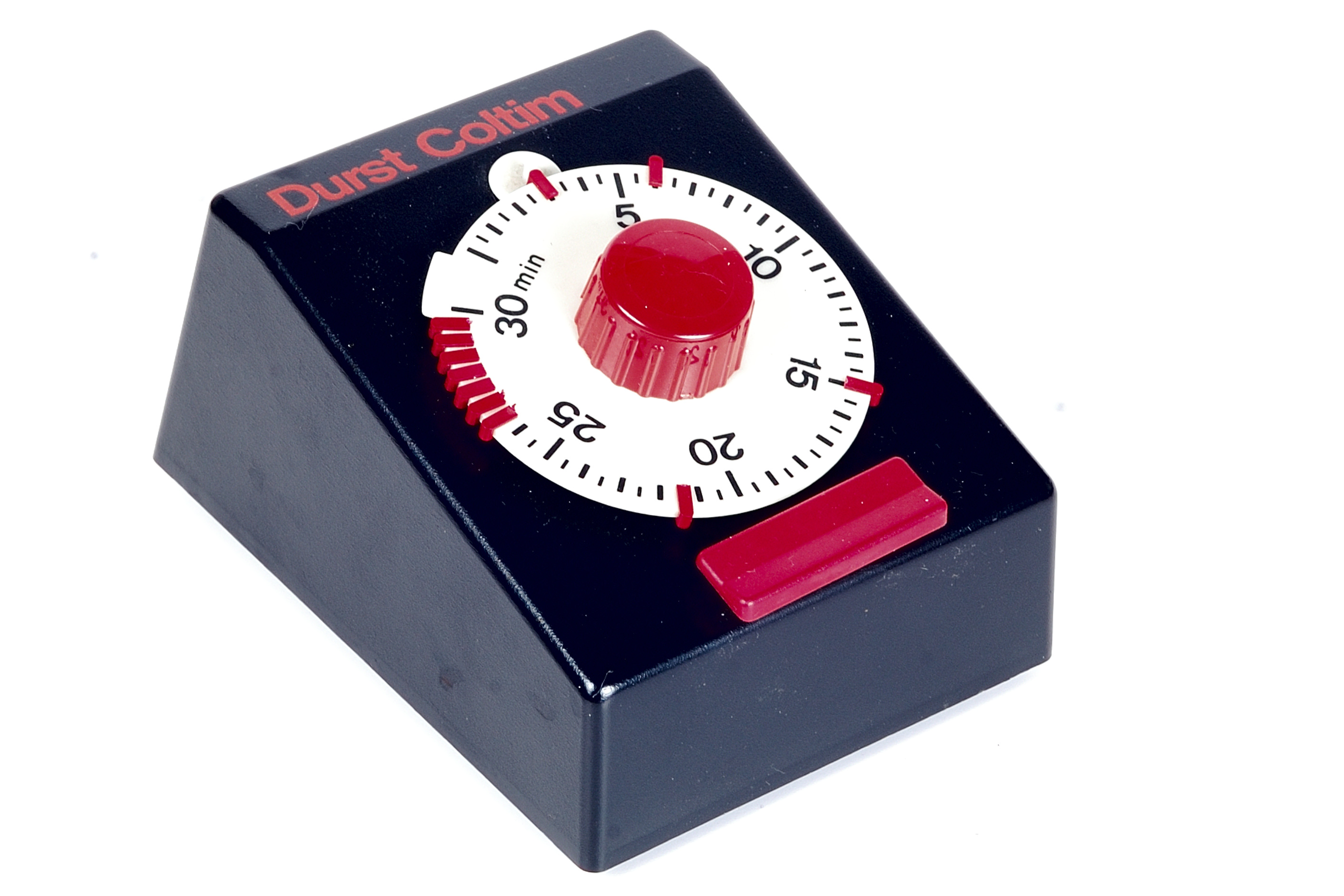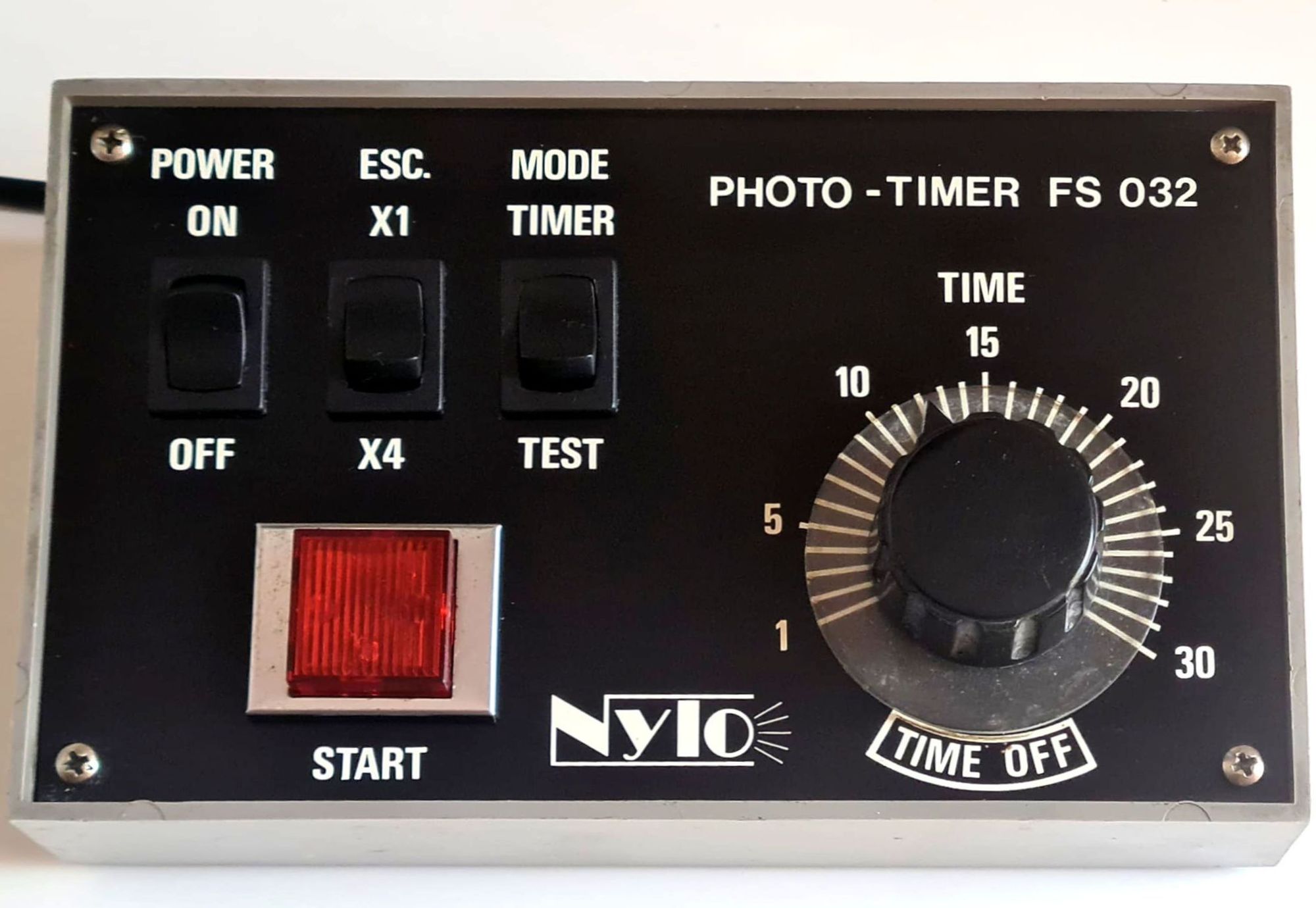Photo-lab Timer on:
[Wikipedia]
[Google]
[Amazon]
A photo-lab timer, photo interval timer, or darkroom timer is a
 Early photolab timers used a
Early photolab timers used a 
 Electronic timers are essentially
Electronic timers are essentially
Agfa - mechanischer Kurzzeitwecker (Timer).jpg, Agfa timer
Fotothek df roe-neg 0006738 010 Exponate des VEB Technische Werkstätten Dresden.jpg, Fotothek Technische Werkstätten
Durst-digitim hg.jpg, Durst-digitim
Analizzatore elettronico, a colori - Museo scienza tecnologia Milano 15481.jpg, Electronic Timer and Analyzer
timer
A timer or countdown timer is a type of clock that starts from a specified time duration and stops upon reaching 00:00. It can also usually be stopped manually before the whole duration has elapsed. An example of a simple timer is an hourglass ...
used in photography for timing the process of projecting negatives to photosensitive paper with an enlarger
An enlarger is a specialized transparency Image projector, projector used to produce Photography, photographic prints from film or glass Negative (photography), negatives, or from reversal film, transparencies.
Construction
All enlargers consist ...
, making photographic prints of them at any scale. It is a device which is attached to the photo lab
A minilab is a small photographic developing and printing system or machine, as opposed to large centralized photo developing labs. Many retail stores use film or digital minilabs to provide on-site photo finishing services.
With the increase in ...
enlarger to ensure that the duration of photo exposures on sensitive paper can be accurately timed. When the selected time has elapsed, the enlarger is switched off or an alarm is sounded, for the photographer to turn it off.
Initially they were conventional clocks, which were replaced by electromechanical timers, which were subsequently substituted entirely by electronic
Electronic may refer to:
*Electronics, the science of how to control electric energy in semiconductors
* ''Electronics'' (magazine), a defunct American trade journal
*Electronic storage, the storage of data using an electronic device
*Electronic c ...
equipment.
Operation
After specifying theexposure time
In photography, shutter speed or exposure time is the length of time that the film or digital sensor inside the camera is exposed to light (that is, when the camera's shutter is open) when taking a photograph.
The amount of light that rea ...
, the supply of power to the enlarger is activated by pushing a start button, thus timing the exposure exactly. The selectable time range is typically from 1/10th of a second to one or more minutes. Most exposure timers also have a continuous light switch, which is especially helpful for framing and focusing. Depending on the version, the desired duty cycle
A duty cycle or power cycle is the fraction of one period in which a signal or system is active. Duty cycle is commonly expressed as a percentage or a ratio. A period is the time it takes for a signal to complete an on-and-off cycle. As a for ...
is set by means of a mechanical dial with scale or a push-button arrangement along with a numerical display. Some variants allow the preselection of several stored timings, which can be called back from memory by a single button press.
Mechanical
 Early photolab timers used a
Early photolab timers used a clockwork
Clockwork refers to the inner workings of either mechanical devices called clocks and watches (where it is also called the movement (clockwork), movement) or other mechanisms that work similarly, using a series of gears driven by a spring or wei ...
mechanism to measure time. Manual timers are usually set by turning a dial to the desired time interval, storing energy in a mainspring
A mainspring is a spiral torsion spring of metal ribbon—commonly spring steel—used as a power source in mechanical watches, some clocks, and other clockwork mechanisms. ''Winding'' the timepiece, by turning a knob or key, stores energy in ...
that operates the mechanism. They work in a way similar to a mechanical alarm clock, the energy of the mainspring causing a balance wheel
A balance wheel, or balance, is the timekeeping device used in mechanical watches and small clocks, analogous to the pendulum in a pendulum clock. It is a weighted wheel that rotates back and forth, being returned toward its center position b ...
to oscillate back and forth.
Each turn of the balance wheel lets the gear train advance a small, fixed amount, causing the dial to move steadily back until it reaches zero, switching off the enlarger or causing a lever arm to strike a bell. The mechanical enlarger timer was invented in the 1920s with a stabilizer that rotates being slowed down by the air resistance
In fluid dynamics, drag, sometimes referred to as fluid resistance, is a force acting opposite to the direction of motion of any object moving with respect to a surrounding fluid. This can exist between two fluid layers, two solid surfaces, or b ...
.
Electromechanical
Short period electromechanical timers for enlargers use a mechanism driven by an AC synchronous motor without any electronic circuitry at all. When the selected time has elapsed, the enlarger is disconnected by means of the relay that kept it on. Theelectric current
An electric current is a flow of charged particles, such as electrons or ions, moving through an electrical conductor or space. It is defined as the net rate of flow of electric charge through a surface. The moving particles are called charge c ...
feeds the synchronous motor which drives a demultiplying gear that rotates the "seconds hand" one turn every minute and simultaneously, the "minutes hand" one turn every hour, thus achieving timings of up to 60 minutes with an accuracy of a tenth of a second.
Electronic
 Electronic timers are essentially
Electronic timers are essentially quartz clock
Quartz clocks and quartz watches are timepieces that use an electronic oscillator regulated by a quartz crystal to keep time. The crystal oscillator, controlled by the resonant mechanical vibrations of the quartz crystal, creates a signal with ...
s with special electronics and can achieve higher accuracy than mechanical or electromechanical timers. Electronic timers have digital electronics
Digital electronics is a field of electronics involving the study of digital signals and the engineering of devices that use or produce them. It deals with the relationship between Binary number, binary inputs and outputs by passing electrical s ...
, but they normally have an analog or digital display
Display may refer to:
Technology
* Display device, output device for presenting information, including:
** Electronic visual display, output device to present information for visual or tactile reception
*** Cathode-ray tube (CRT), that uses an el ...
.
Integrated circuit
An integrated circuit (IC), also known as a microchip or simply chip, is a set of electronic circuits, consisting of various electronic components (such as transistors, resistors, and capacitors) and their interconnections. These components a ...
s have made digital logic
A logic gate is a device that performs a Boolean function, a logical operation performed on one or more binary inputs that produces a single binary output. Depending on the context, the term may refer to an ideal logic gate, one that has, for ...
so cheap that an electronic timer is now less expensive than the classical mechanical or electromechanical timers. Individual timers are implemented as a simple single-chip computer system
A computer is a machine that can be programmed to automatically carry out sequences of arithmetic or logical operations (''computation''). Modern digital electronic computers can perform generic sets of operations known as ''programs'', wh ...
, similar to a clock
A clock or chronometer is a device that measures and displays time. The clock is one of the oldest Invention, human inventions, meeting the need to measure intervals of time shorter than the natural units such as the day, the lunar month, a ...
and usually using the same, mass-produced
Mass production, also known as mass production, series production, series manufacture, or continuous production, is the production of substantial amounts of standardized products in a constant flow, including and especially on assembly lines. ...
technology.
Automatic timer/analyzer
There is a type of automatic timer manufactured by Kaiser, Philips, and others that by means of a photoelectric sensor (like the one in the photo or mounted inside the easel), is capable of regulating the exposure time according to the light projected by the enlarger, through the negative, on thephotographic paper
Photographic paper is a coated paper, paper coated with a light-sensitive chemical, used for making photographic prints. When photographic paper is exposed to light, it captures a latent image that is then Photographic developer, developed to form ...
, magnitude inversely proportional to the darkness of the negative and its the distance to the paper.
Gallery
References
External links
* {{cite web , title=Darkroom Process control / Timers , website=fotoimpex.com analogue photography , url=https://www.fotoimpex.com/darkroom/process-control-timers/ , ref={{sfnref , fotoimpex.com analogue photography , access-date=2023-04-21 Clocks Photography